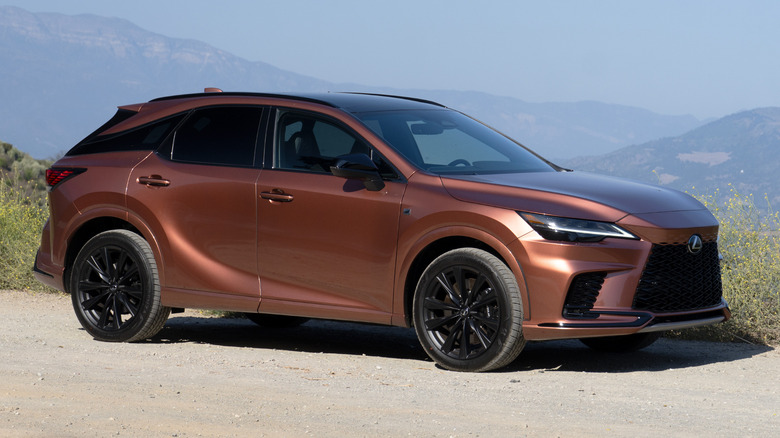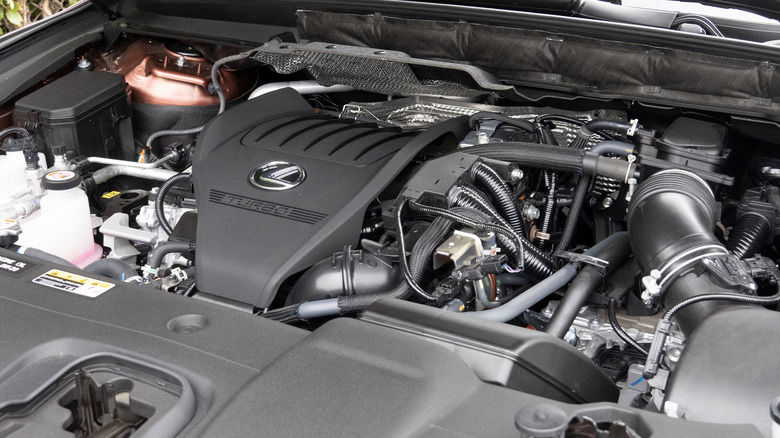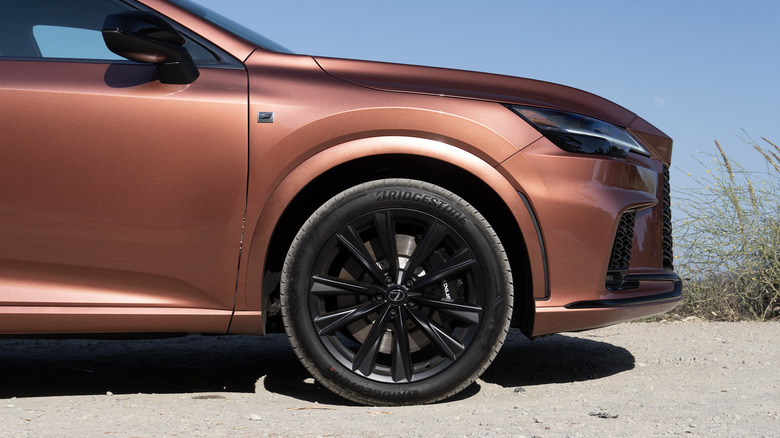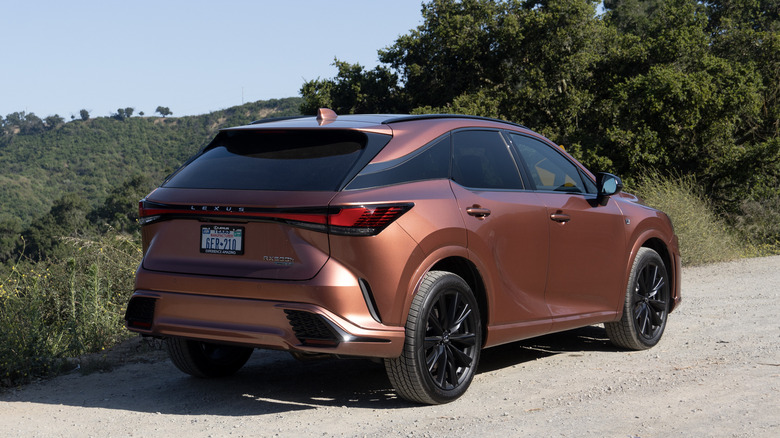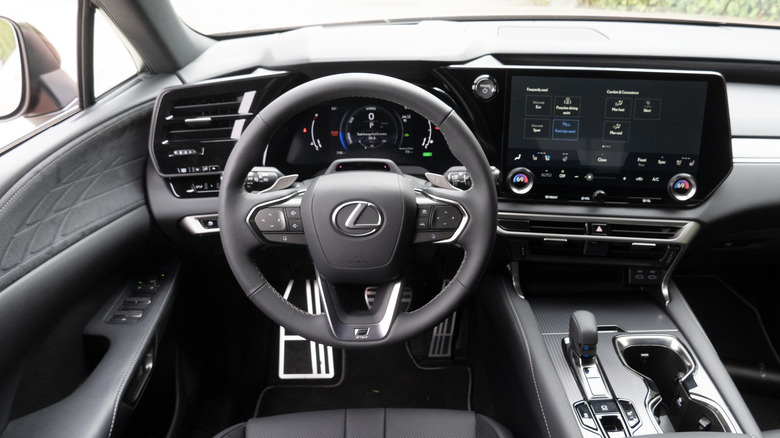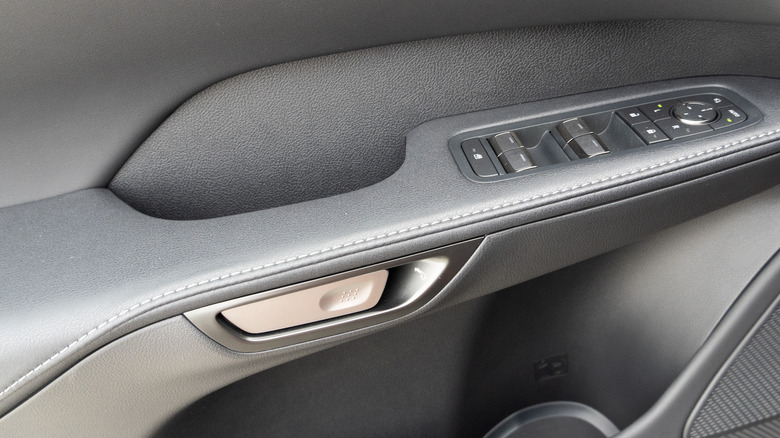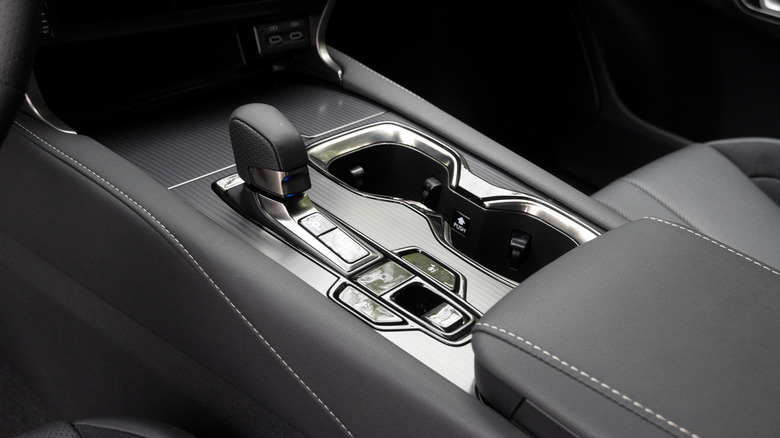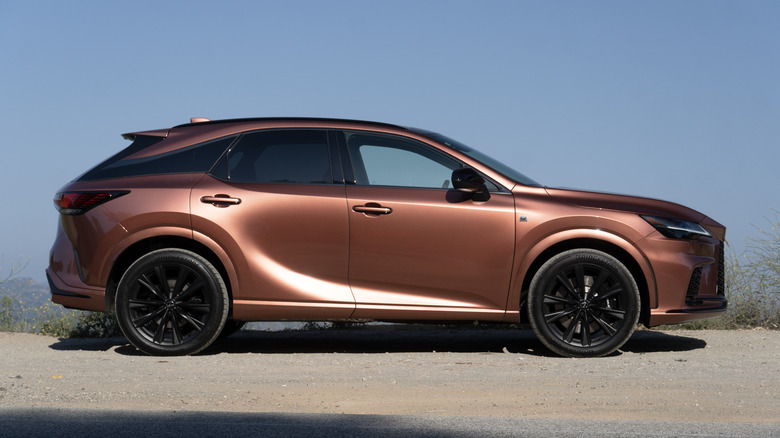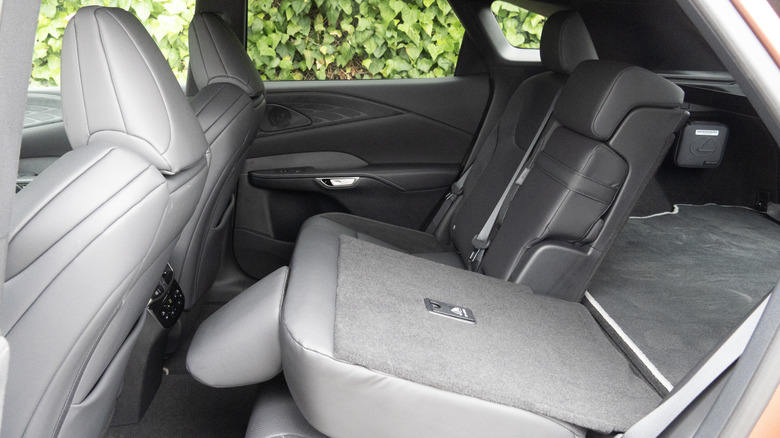2023 Lexus RX 500h F Sport Performance Review: Too Much Of Everything
- Peppy hybrid drivetrain
- Impressive handling for a family crossover
- High-quality materials used for the interior
- Toyota & Lexus reliability
- Unfortunate design from every angle
- Intrusive tech borders on dangerous
- Priced too high among stiff competition
Automakers always love to give out the boldest colors for press loan vehicles. The strategy seems simple enough: Bright shades stand out best in photos, while turning more heads in real life as journalists and influencers drive around testing the cars. But even knowing that, my eyes truly popped when this Lexus RX 500h F Sport Performance rolled up finished in Copper Crest.
Almost a rose gold with a hint of rust thrown in for good measure, maybe Copper Crest perfectly complements the RX SUV's top trim and spec, which starts at $63,745. This model year marks the first time Lexus decided to add the F Sport Performance trim to the RX at the top of the lineup for the all-new fifth generation—but the performance enhancements don't come cheap, since this exact car pushes over $70,000 out the dealer door as optioned.
To find out whether the F Sport Performance package, previously seen on the beefy V8-powered IS 500 sedan, also mates well with the RX 500h's hybrid drivetrain, I took the luxury crossover for a dry and dusty summer road trip from Los Angeles over the mountain roads to Solvang, north of Santa Barbara.
Road tripping in a Lexus F Sport Performance
The RX arrives all-new for 2023, with three new powertrain options. The top 500h hybrid's total combined rating of 366 horsepower can't match the IS 500's 472 ponies, but the 2.4-liter inline-four's turbocharger and the 80-kilowatt electric motor work together to produce serious torque at 406 lb-ft (or 11 more pounds of twist than the V8). That grunt routes to all four wheels through a six-speed automatic and Lexus' "eAxle" rear drive unit that combines the electric motor, inverter, and reduction gearbox in one unit.
All told, the RX 500h weighs around 4,700 pounds and can manage a 0-60 time of 5.9 seconds. But it feels faster, with plenty of pep from the drivetrain throughout the rev range, even in Eco mode trying to maximize fuel economy. Paddle shifters control the six-speed gearbox, rather than adjusting regenerative braking as on some full EVs or CVT-equipped hybrids, but even still, I managed to average 26.6 MPG over almost a full tank of gas, or just shy of 500 miles of cruising and sporty driving mixed. Not bad considering ratings of 27 and 28 MPG for city and highway respectively.
Pushing hard in Sport mode, the transmission keeps that four-banger at higher revs until the engine runs out of juice at the top end—and never sounds particularly good anyway. Lexus obviously prioritized torque delivery at lower RPMs.
A confusing combination of performance enhancements
The RX's standout performance aspect isn't power in the first place, turns out. Instead, a chassis tuned with adaptive dampers keeps body roll to a minimum on winding mountain roads, while also somehow staying supple enough to iron out road imperfections from the smallest pebbles to speed bumps in town. The impressive ride quality both during normal and sporty driving left me only wondering whether a non-hybrid RX 350, which tips the scales around 500 pounds less, might handle even better with the F Sport Performance package's goodies.
A set of 21-inch Gloss Black alloy wheels provide the only real exterior cue that hints to this RX's performance-enhancing regimen. But four-wheel steering also fits into the mix, providing a hint of help while driving but mostly a solid turning radius for a mid-sized crossover. Lexus did equip this press loaner with Bridgestone Alenza Sport all-season tires, though, which quickly run out of grip at the limit and may tone down the potential for more impassioned cornering when compared to a set of optional Michelin tires.
Unfortunately, some of the more positive elements of the RX also get dulled down by somewhat uninspired steering feedback—a real bummer given the relatively precise point-and-shoot directionality. And both the brakes and paddle shifters fall short in terms of snappy responses, the former perhaps wanting for more regen and the latter compensated by that low-end torque. To an extent, the performance winds up in the peculiar Venn Diagram of other high-end Lexus models, including the LC, RC, and IS, where every bright spot seemingly gets countered by something that leaves a bit to be desired.
Styling divorced from driving dynamics
Probably the single biggest question mark for the new RX falls in line with just about every Lexus other than LC: styling entirely divorced from driving dynamics. For a family crossover, the RX drives surprisingly well. But the exterior design lacks the kind of coherent statement to match. Similarly in the cases of the RC and IS, the angular and swooping lines belie somewhat staid on-road behavior. The LC, meanwhile, manages the middle ground of a luxurious grand tourer. And then we have the RX, which arrives for the new generation with only one good angle.
From the front, the sharknose hood falls over a ballooning grille. From the tail end, a bulbous trunk conflicts with the full-width light bar, swooping quarter panel glass, and faux air exits behind the rear tires. Only the dead-on side profile lines even somewhat suit the overall form (other than the aforementioned rear quarter-panel glass, that is).
No RX ever looked particularly good per se, ever since the first generation debuted for model year 1999. But this more aggressive pivot for gens four and five turned out especially confusing—and the paint shade reminiscent of funky skin contact rosé doesn't help at all. Maybe a dark green or metallic silver might help cover up the design's shortcomings, about which absolutely everyone I met in the RX couldn't help but make snide comments.
Interior design and high-quality materials
That aggressive styling continues on the interior, too, with dash lines that flow into embossed Alcantara on the door cards. The goal might have been to impart an edge that the F Sport Performance denotes, though the result doesn't maximize use of space below the raked windshield—and certainly wouldn't mesh with the ethos of lower trim levels.
The seats, on the other hand, perfectly fit my body at 6'1" and 170 pounds, though the firm bolsters may squeeze thighs and waistlines for buyers more accustomed to comfortable family crossovers. The backseats also provide reasonable head and legroom, and do fold down with a convenient 40:20:40 split to provide additional storage when the respectable trunk simply won't fit larger luggage.
At the very least, nobody will dislike the RX's high-quality materials at every touchpoint, since Lexus even eschewed using almost any of the nearly ubiquitous piano black plastic that ruins so many luxe interiors these days. Instead, textured plastics that vary between gloss metallic, matte black, and almost faux carbon work together quite well.
Finally, a full-on touchscreen
Lexus also seems to have finally gotten past the brand's downright confusing years of late playing with trackpads and dials for controlling infotainment and climate control. Instead, the new RX joins the rest of the modern automotive age with wireless Apple CarPlay on a 14-inch true touchscreen. The RX also uses the best head-up display I've seen yet—mostly because it's the smallest head-up display I've seen yet, that also uses a nifty highlighting system for the adaptive cruise control, drive modes, speaker volume, and song selection.
Unfortunately, that head-up system then makes the steering wheel buttons somewhat incomprehensible while looking at the main gauge cluster. And using the center console to select drive modes or adjust climate control settings also requires diving into excessive menu pages.
Really, the entire RX goes entirely overboard on tech, unnecessarily reinventing the wheel to the point that formerly intuitive tasks require a second or two of thought to actually get right. For starters, the exterior door handle uses a small electronic button, rather than actually, you know, pulling outward as the traditional door handle shape my suggest. Then on the inside, a tiny door handle can push inward as an electronic button or pull outward to open the door as an emergency stopgap—in the case of an emergency. It is, in fact, an elegant solution. But a solution to a problem caused by the use of a tiny, electronic door handle...
We need to talk about tech
Meanwhile, a tiny shifter the size of a petite thumb uses the same strange shift selection pattern previously found on the RC, LC, and IS. To be fair, the directions for Drive, Reverse, or Neutral can at least feel somewhat natural after a short period of acclimation. Selecting Park, however, via the electronic button below only gets more frustrating when the electronic parking brake automatically turns on or off only some of the time.
The suite of driver aids that Toyota on the RX calls "Lexus Safety System+ 3.0" also intrudes on actual driving constantly, far beyond the time it took me to adjust to the shifter. A driver inattention camera visible above the steering wheel worked predictably until I put on sunglasses, at which point the system started dinging to an irritating amount—and caused me to look down at the gauge cluster excessively hoping to find out what was wrong, literally taking my eyes off the road because it was worried that my eyes were not on the road. The adaptive cruise control, meanwhile, includes lane-keep-assist steering that will pull hard into oncoming traffic, then start dinging similarly once over the line it pulled the car across.
Automatic emergency braking also kicked in multiple times while I tried to park, both parallel and head-in. The sensation of slamming to a stop while trying to nudge a few more inches forward or backward often made me think maybe I had hit a wall or bush or car—but better safe than sorry seems to be the thinking from Lexus here.
I do believe that driver aids can make cars safer, whether during the course of everyday driving on the highway, in cities where pedestrians might leap out at any moment, or while parking in tight urban environments. But the safety systems go too far on the RX, with incessant dinging and unpredictable behavior that drew my attention away from the actual driving. While a little nudge might help drivers distracted by text messages or social media or whatever's going on in the backseat, many of the warnings will likely distract responsible drivers actually paying attention to the road... Or, for example, those trying to enjoy everything good about the RX 500h F Sport Performance.
Not quite as unique a crossover as intended
Lexus probably looked at the crowded crossover market and figured that adding three drivetrain options and the F Sport Performance package to the all-new RX lineup couldn't hurt sales. But where the IS 500's F Sport Performance ups the appeal of a four-door five-seat sedan powered by a naturally aspirated V8—essentially a unique combination other than the Dodge Charger, which isn't really in the same segment—the top-spec RX now faces stiff competition given the $70,000-plus price tag.
In something of a coincidence, I recently took a Mercedes-Benz GLC 300 4Matic on nearly the same road trip as the RX 500h. Now equipped with a 48-volt mild hybrid system, the Benz delivered better fuel economy in a cleaner package, with a more luxurious ride and more space for front and rear passengers. Though not quite as quick or tight as the F Sport Performance RX, the Benz starts at $49,100—a few hundred bucks less even than a base RX350h hybrid without the top trim package.
Crossovers facing tough competition
And this Lexus also costs more than a Porsche Macan. Let that sink in. The cheapest of Porsche's entry-level crossovers runs $60,900 and, despite lacking any hybrid assist, the torquey turbocharged inline-four still manages EPA ratings of 19 MPG city and 25 MPG highway. All credit to Stuttgart's engineers, since the Macan can also log a 0-60 time only a tenth of a second behind the much more powerful Lexus.
Toyota and Lexus fans may point out the two companies' long history building reliable hybrids, but of the German manufacturers, Mercedes and Porsche can probably best match any reliability concerns with their respective best-sellers, too. And that's not even mentioning the panache factor. Impressive driving dynamics, respectable power, and understated luxury all hint at why Americans buy more RX crossovers than any other Lexus—but that's almost in spite of the unfortunate styling and unnecessary tech. Now imagine if Lexus borrowed more cues from Toyota's undeniably better driver-aid systems, or finally managed to hit the design elements out of the park. Then the F Sport Performance package might present a little less sticker shock.
